12 Fun Activities that Engage Young Children’s Senses and Enhance Learning
December 7, 2023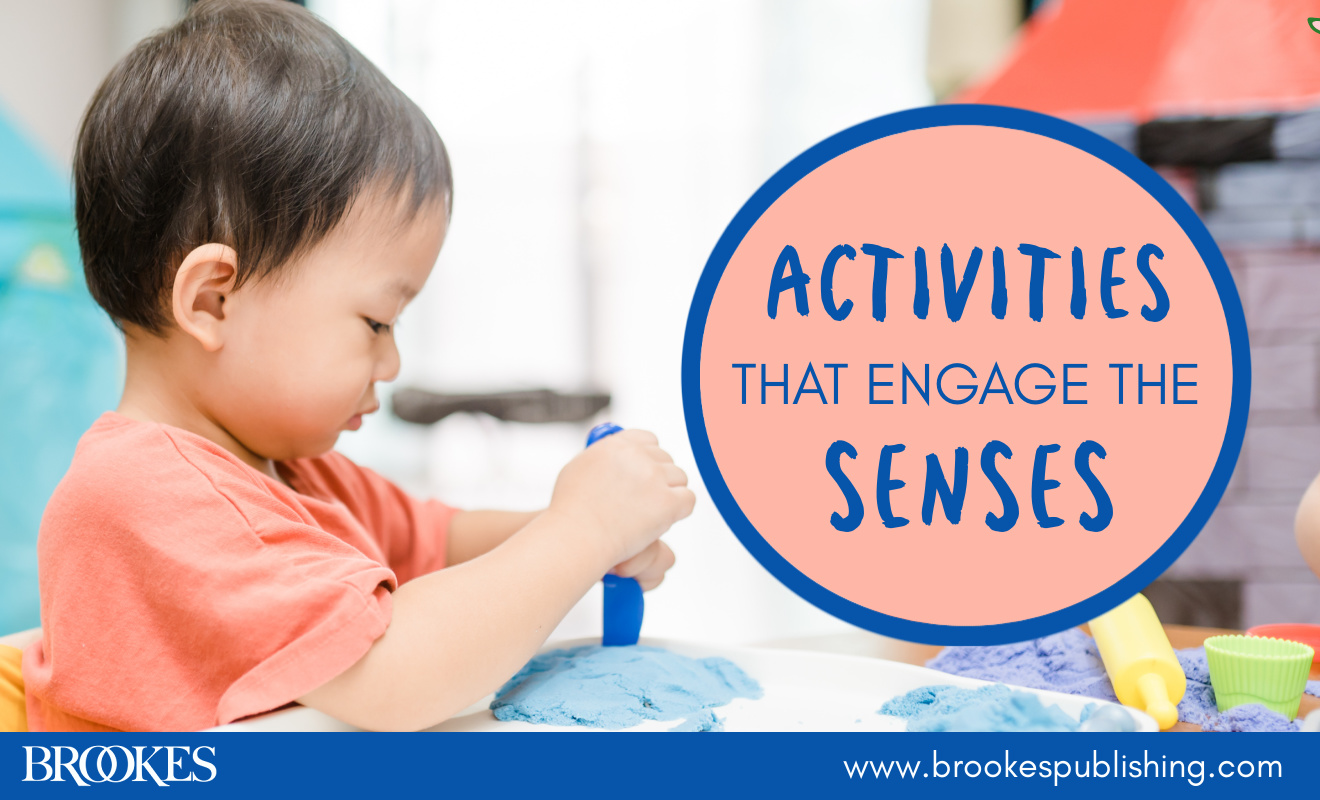
Prepare for the long winter months ahead with some fun new activities to try with the young children in your life. Adapted from some classic and bestselling Brookes books, these activities engage young children’s senses and help boost key areas of development at the same time. They’re perfect for sharing with families, and many can be used in early childhood programs, too!
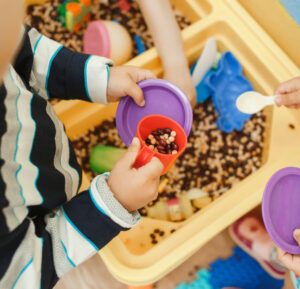 Create a sensory bin by filling a covered plastic container with rice or dried oatmeal. Gather small objects such as balls, toys, or toy animals to the box along with spoons and scoops you have in your kitchen. Allow your child to experience the feel of the grain and practice the fine-motor skills of scooping and pouring. Place the bin on a large tablecloth or blanket to make cleanup easier. Ask the child to find the item you request in the bin. You can also ask her to sign the names of the items she finds. “Where is the CAT? Give me the BALL.” (See this book for an introduction to the how and why of teaching signs to young children.)
Create a sensory bin by filling a covered plastic container with rice or dried oatmeal. Gather small objects such as balls, toys, or toy animals to the box along with spoons and scoops you have in your kitchen. Allow your child to experience the feel of the grain and practice the fine-motor skills of scooping and pouring. Place the bin on a large tablecloth or blanket to make cleanup easier. Ask the child to find the item you request in the bin. You can also ask her to sign the names of the items she finds. “Where is the CAT? Give me the BALL.” (See this book for an introduction to the how and why of teaching signs to young children.)
Make some “sound toys.” Try an empty Tic Tac box, a film canister, a potato chip can, or a plastic Easter egg. Add dried rice or popcorn kernels inside. Be certain the lids are glued and taped to keep the contents out of the child’s mouth. Electrical tape can be purchased in primary colors from your local hardware store and is good for securing the closures on your sound toys. These sound toys are great accompaniments any time you would like to sing with children.
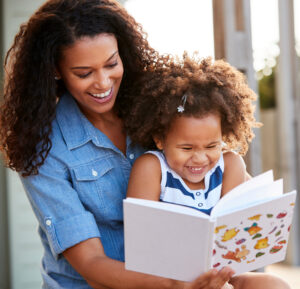 Sing a picture book. Try singing all or a portion of one of your favorite picture books. Select one with rhythm, rhyme, and repetition, and either borrow a melody or make up one of your own. (Singing a book provides the added benefit of supporting emotional regulation. The experience of listening to the book as it’s sung and gazing on the illustrations helps children self-calm and be present in the shared book experience.)
Sing a picture book. Try singing all or a portion of one of your favorite picture books. Select one with rhythm, rhyme, and repetition, and either borrow a melody or make up one of your own. (Singing a book provides the added benefit of supporting emotional regulation. The experience of listening to the book as it’s sung and gazing on the illustrations helps children self-calm and be present in the shared book experience.)
Make homemade juice. Make orange juice or lemonade with children. Have them help squeeze the fruit using a handheld juicer. Show them how to twist the fruit back and forth to get the juice out (add some sugar and water if you’re making lemonade). Let the child help you stir it all up and taste the juice together.
 Enlist children as cooking helpers. Let your child help prepare meals by measuring, pouring, stirring, washing, and tearing greens. With your help and a plastic knife, they can even cut soft foods, such as bananas. Children can also help make their own snack—they can help twist open lids on jars; open containers; spread cream cheese, hummus, butter, jam, or jelly; scoop out applesauce; and more. Talk about how the foods taste and smell.
Enlist children as cooking helpers. Let your child help prepare meals by measuring, pouring, stirring, washing, and tearing greens. With your help and a plastic knife, they can even cut soft foods, such as bananas. Children can also help make their own snack—they can help twist open lids on jars; open containers; spread cream cheese, hummus, butter, jam, or jelly; scoop out applesauce; and more. Talk about how the foods taste and smell.
Play “What’s That Sound?” Listen with children to sounds around your home. Listen to the refrigerator motor, wind chimes, a clock ticking, or people talking. Ask the child to tell you what she hears. You can try this this at night, too: listen for the night sounds of crickets, frogs, or cars beeping. Whisper to each other about what you hear.
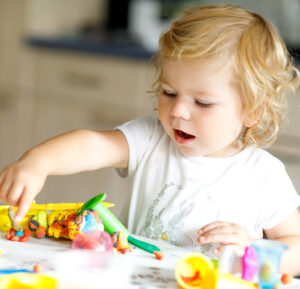 Create homemade play dough. Mix up a batch of play dough with children: 2 cups flour, 1 cup salt, 1 teaspoon oil, 1 cup water. Squish it all up with clean hands. Give children a flat cookie sheet or placemat with a bit of flour on it to keep dough from sticking. Kids will enjoy pinching, pounding, rolling, and squeezing the dough. Add Popsicle sticks or a cookie cutter for more fun! Store in a plastic container in the refrigerator, and let children help clean up with a damp cloth.
Create homemade play dough. Mix up a batch of play dough with children: 2 cups flour, 1 cup salt, 1 teaspoon oil, 1 cup water. Squish it all up with clean hands. Give children a flat cookie sheet or placemat with a bit of flour on it to keep dough from sticking. Kids will enjoy pinching, pounding, rolling, and squeezing the dough. Add Popsicle sticks or a cookie cutter for more fun! Store in a plastic container in the refrigerator, and let children help clean up with a damp cloth.
Experiment with colors. When children know the names of colors, they can better describe the world and make requests more precise. (Some days, only the pink shirt will do.) Experimenting with different colors and combinations of colors while creating a masterpiece of art, a delicious snack, or a special book provides great opportunities for exploring while having fun and talking about many different things related to colors.
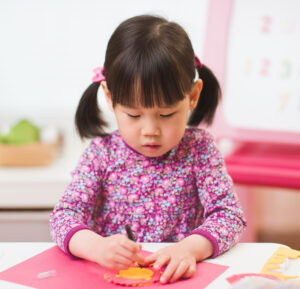 Infuse many textures and materials into art exploration. Start by reading your child some favorite picture books and talking about the different techniques the artists used for the illustrations. Then have the child practice fine motor skills by making books or illustrations of their own, using materials such as watercolors, paste, paper, cloth scraps, ribbon, foil, string, stamps, greeting cards, and box tops. When they’re done, your kids can hang their masterpieces in a special gallery area or “read” their illustrated books to you or each other.
Infuse many textures and materials into art exploration. Start by reading your child some favorite picture books and talking about the different techniques the artists used for the illustrations. Then have the child practice fine motor skills by making books or illustrations of their own, using materials such as watercolors, paste, paper, cloth scraps, ribbon, foil, string, stamps, greeting cards, and box tops. When they’re done, your kids can hang their masterpieces in a special gallery area or “read” their illustrated books to you or each other.
Construct a rainmaker. Give each child a toilet paper roll to use to create a rainmaker. They can decorate the roll with crayons or markers. Tape one end shut after the child has finished decorating the roll, and have the child place a few dry beans or other small items (e.g., Cheerios, grass seed) inside the roll. Tape the other end shut and have the child shake the roll. The noise will sound like rain.
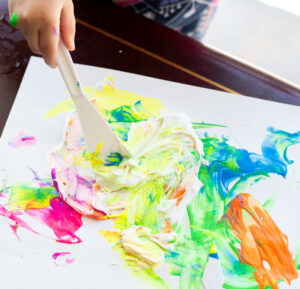 Paint with shaving cream. Some children will love fingerpainting—a good excuse to get messy and gooey. Put a dab of shaving cream on a tray or placemat. Children can use their hands and fingers to smear the cream all over the board, then use their fingers to draw and write in the shaving cream. The children can also make abstract designs, make full handprints, or use their fingers to practice writing letters or numbers.
Paint with shaving cream. Some children will love fingerpainting—a good excuse to get messy and gooey. Put a dab of shaving cream on a tray or placemat. Children can use their hands and fingers to smear the cream all over the board, then use their fingers to draw and write in the shaving cream. The children can also make abstract designs, make full handprints, or use their fingers to practice writing letters or numbers.
Have fun with a “feely” bag. Introduce a feely bag that has a drawstring top and contains several objects. Tell the children that they are going to try to guess what an object is by using their sense of touch. To demonstrate, put a hand into the bag and, without looking, try to identify an object. Problem-solve out loud by saying something like “It feels sort of round, it is soft, I know—it’s a Nerf ball!” Have children try to identify an object by feeling it in the bag. Ask them, “What was easy and what was hard about guessing the object?”
Use these fun sensory activities to strengthen bonds with young children this winter and enhance their development in key areas, including motor skills, communication, and problem-solving. Share today’s post with the parents you know, and feel free to recommend your own favorite activity in the comments below!
P.S. Don’t forget that activities should be supervised at all times by an adult. Any material, food, or toy given to a young child should be reviewed for safety.
- Activities 1-3 adapted from Sing & Sign for Young Children by Anne Meeker Watson
- Activities 4-7 adapted from ASQ®-3 User’s Guide by Jane Squires, Ph.D., Elizabeth Twombly, M.S., Diane Bricker, Ph.D., & LaWanda Potter, M.S and ASQ®-3 Learning Activities by Elizabeth Twombly and Ginger Fink
- Activity 8 adapted from Developmental Parenting by Lori Roggman, Lisa Boyce, and Mark Innocenti
- Activity 9 adapted from Talk to Me, Baby! by Betty Bardige
- Activities 10-12 adapted from Early Literacy in Action by Betty H. Bunce

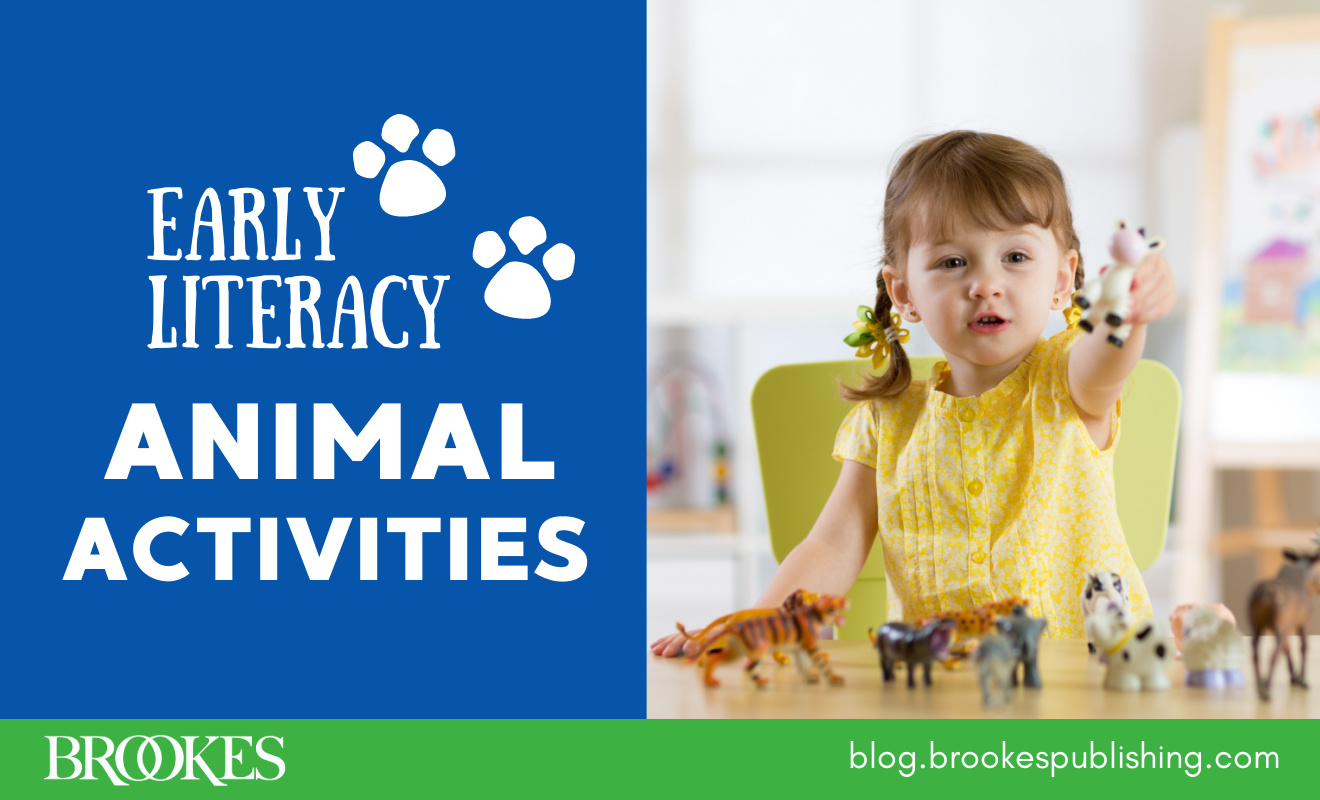

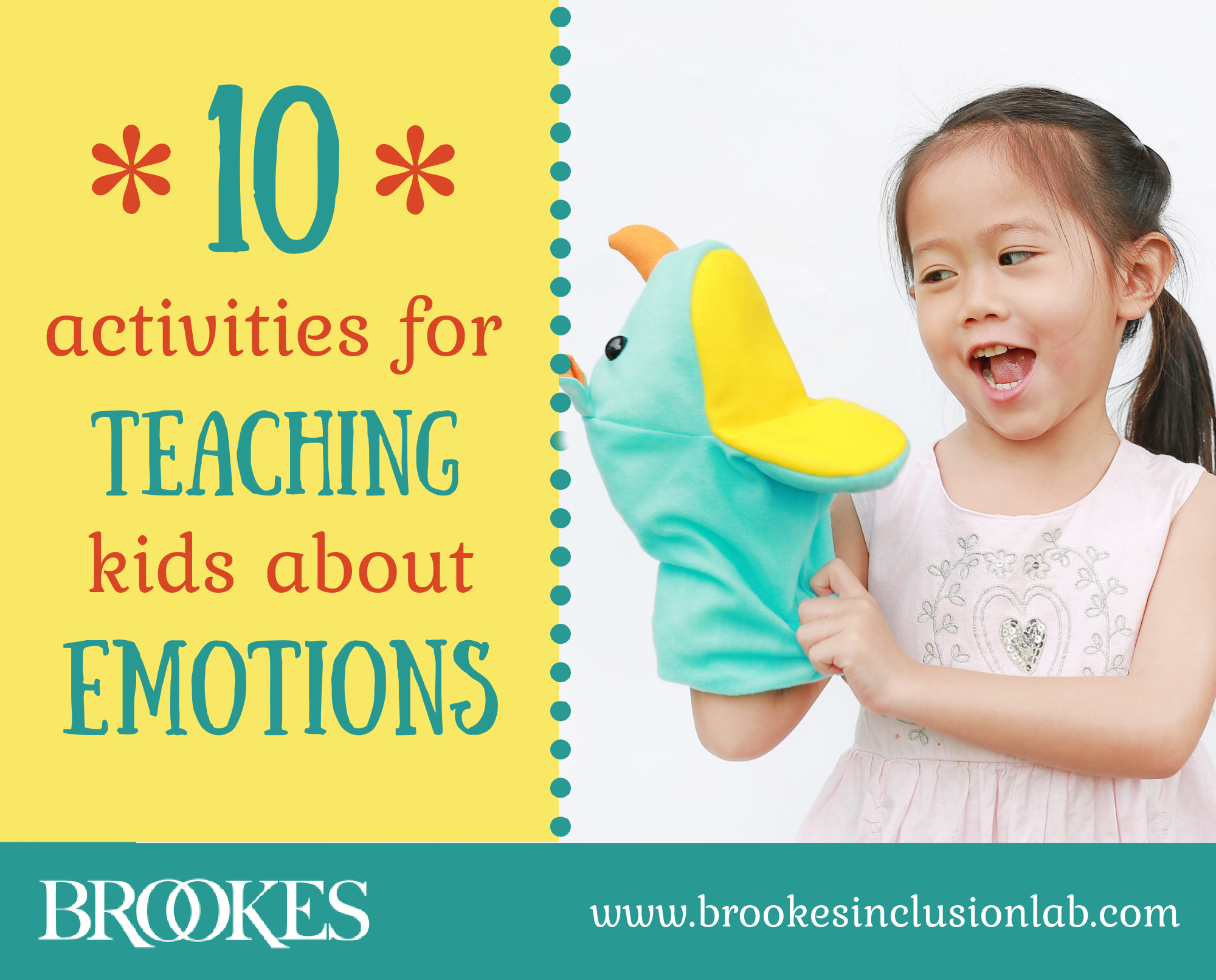
Write a Comment
Your email address will not be published. Required fields are marked *
Post a Comment